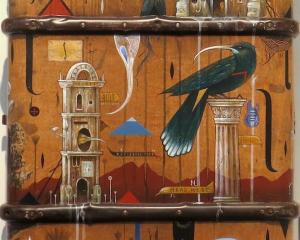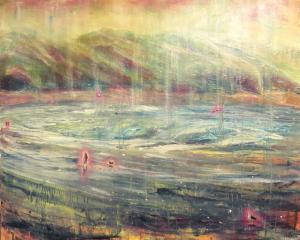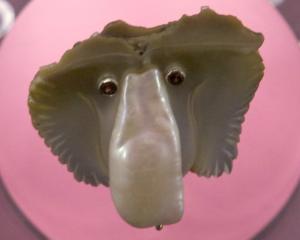In this week's Art Seen, James Dignan looks at exhibitions from Hocken Collections Gallery, The Artist's Room and Fe29 Gallery.
 Untitled (Flower Study), by Doris Lusk.
"Sisters Communing'', (Hocken Collections Gallery)
Untitled (Flower Study), by Doris Lusk.
"Sisters Communing'', (Hocken Collections Gallery)

The Hocken is celebrating the 125th anniversary of women's suffrage with an impressive display of works by some of New Zealand's most acclaimed female artists.
``Sisters Communing'' presents work ranging from Grace Joel's fin de siecle Mother and Child to recent works by the likes of Yuki Kihara, with plenty of highlights in between. Works are not grouped by theme or style, but form a narrative which covers many aspects of identity and place within New Zealand. As such, each item is a revelation, and the unexpected interplay of neighbouring works creates artistic dialogues between the various pieces. Two cabinets sit at the centre, containing art and ephemera charting the course of women's suffrage in New Zealand.
There are many delights here. A diptych by Joanna Paul and two Gretchen Albrecht works dominate the gallery's main room, alongside fine works by Doris Lusk, Robin White, Frances Hodgkins and Glenda Randerson. In one side gallery, photographs predominate, led by a large Christine Webster work and impressive images by Adrienne Martyn and Margaret Dawson - the latter a reworking of Dorothea Lange's most famous dust bowl-era image. A large mixed media work by Julia Morison is also of note. The third gallery space contains fine work by Louise Henderson and a smile-inducing painting by Joe L'Estrange.

"Between Realms'', (The Artist's Room)
Three artists share the limelight at The Artist's Room in ``Between realms''.
Jane Crisp is perhaps the best-known of the three, with her impressively realistic acrylic bird studies. In works such as The Gift and the delicately captured fantail of Untethered Soul, the artist effectively captures the moment and the life of the bird.
Gillian Buckley's images painstakingly capture the human form, mostly via the medium of graphite drawings. In works such as The Thinnest Thread and Little Pieces, personality and expression are beautifully evoked, and fine details such as hair and skin texture are excellently depicted.
The third artist, Gemma Campbell, is showing works for the first time in Dunedin. Her works, painted in oils or acrylics on aluminium, bridge the realms created by Crisp and Buckley's art with strong magical realist images depicting a strange symbiosis between humans and animals. In each of these paintings, one human protagonist is shown alongside birds and insects, perhaps most effectively in the poignant Tea for Three. In many of the images, backgrounds have been reduced to a nebulous darkness, allowing the figures to shine forth from the gloom. Campbell has also presented a handful of fine etched works, such as The Dog, the Rabbit, and the Tortoise, which similarly capture the essence of the animals depicted.

"Three Friends, Three Paths'', (Fe29 Gallery)
Another trio is in the spotlight at Fe29 - prominent artistic friends who carved their own significant paths in New Zealand art: Robert Macdonald, and the late Don Peebles and John Drawbridge. Surprisingly this is the first group exhibition to feature the trio's work.
Peebles' work is largely represented by a series of intriguing small abstract impressions on unstretched canvas, dating from the 1990s. These works are complemented by a group of more experimental earlier works, some of them containing three-dimensional elements, and several fine works on stretched canvas from the last years of Peebles' career.
Macdonald's display predominantly features linocuts and etchings depicting scenes from New Zealand history. The dynamic strength of his Fifth Wind linocuts is particularly memorable. The display is dominated by two impressive acrylic re-imaginings of Gottfried Lindauer portraits of Maori warriors which add a splash of bright colour to the otherwise muted tones of Macdonald's art.
The John Drawbridge works on display are the most diverse in the exhibition, ranging from ink line drawings and watercolour landscapes to geometric abstraction. There is, however, a distinct progression shown, from his charming early ink works, created while a student in England, through the abstract designs which dominated his time in Europe, to the bold explorations of light and colour which emerged in the artist's later years.




![... we all become all of these things [installation view] (2025), by Megan Brady.](https://www.odt.co.nz/sites/default/files/styles/odt_landscape_small_related_stories/public/story/2025/03/1_we_all_become_all_of_thes.jpg?itok=nicA_yAm)


![Poipoia te Kākano [installation view]. Allison Beck, Megan Brady, Kate Stevens West, Jess...](https://www.odt.co.nz/sites/default/files/styles/odt_landscape_small_related_stories/public/story/2025/02/1_poipoia_te_k_kano.jpg?itok=ssJ8nxyx)




